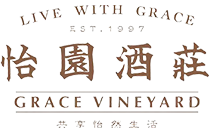Determination and Nature in Shanxi : the Grace Vineyard Lesson
Author:
Source:
Release time:
2021-02-26
Great wines are as much the result of man’s determination as they are of Nature and I’ll tell you a story to prove it. In the Shanxi Province of China, there lived a man who became very rich from trading iron and coal. This man is one of the many who decided to devote some of their time and money to producing wine. After some hesitation, he decided that there was no better place to fulfil his dream than in his adopted land, and he created his vineyards and winery in the Taigu area of China’s Shanxi Province.
The site chosen was the best from an emotional standpoint, but it was far from perfect for the production of quality wine, according to the textbooks. The dry climate required an irrigation system to be put in place, and the poor distribution of rainfall, mostly in summer, increased the risk of rot and the frequency of treatments. The growing season was short; it turned from summer to winter in a matter of days, and nighttime temperatures were already freezing by October. Lastly, the soil - fairly sandy, unstructured and deep, over hundred metres, offered no benefit other than being fast-draining. Maybe that is why Denis Boubals, the late, great Bordeaux oenologist, with the Bordeauxlike obsession for draining soils, recommended planting Cabernet in this area. Chun-keung Chan, for that is the name of our hero, dealt with these problems pragmatically: he first planted the Bordeaux varieties, as these sell well in China, and then many other varieties, tirelessly experimenting. He hired leading experts, such as the Australian, Ken Murchison, and built himself a winery boasting the very best equipment.
As if the adverseness of nature was not enough, the local community also presented enormous challenges. For a start, neither Mr. Chan, nor anybody else in China, may own land. Land can only be rented from the Chinese State for 50 years. This would not seem to offer the greatest of incentives to invest in vineyards which can take decades to turn a profit. Then there was the fact that, when he first arrived, nobody in Shanxi knew how to cultivate vines to produce quality wine. But it was obvious that, for his project to succeed, his business would have to be based on buying grapes from third parties, today some 600 families, and to employ local labour.
Today Grace Vineyard produces around 2 million bottles, with retail prices ranging from €8 to €75 per bottle. On a recent visit I was able to taste their range. Of the wines available on the market, I would pick out the following:
TASYA’S Reserve Chardonnay 2011.
In a very modern style, fairly oaky with good tropical fruit. €25
TASYA’S Reserve Cabernet Sauvignon 2012.
Aromas, round, fresh, attractive. €39
DEEP BLUE 2011 / 78% Cabernet Sauvignon, 22% Merlot.
Intense, very fruity, velvety, rich, juicy. €40
CHAIRMAN’S Reserve 2011 / 70% Cabernet Sauvignon, 15% Merlot,15% Cabernet-Franc.
Densely structured, very fine aromas on the nose and on the finish,tense, very classy.€74.
The 2012 is even more spectacular, very finely woven.However, my two favourite wines were not for sale. The first is a blanc de blancs 2009 called Angelina, a 100% Chardonnay of great complexity and freshness with beautiful brioche and citrus aromas on the nose. Judy tells me that they prefer to drink it themselves rather than sell it, and I can understand why. Aglianico is 2012 Taysa’s Reserve Aglianico, and the Special Edition Chairman’s Reserve is the 2010 vintage, another top quality wine (95% Merlot & 5% Cabernet Sauvignon). Ken Murchison finds the latter a little lean, but for me it is delightfully delicate, it speaks of an origin, embodies the dream of its father, Mr. Chan, and illustrates that terroirs are created by the union of Nature and the determination of man.

